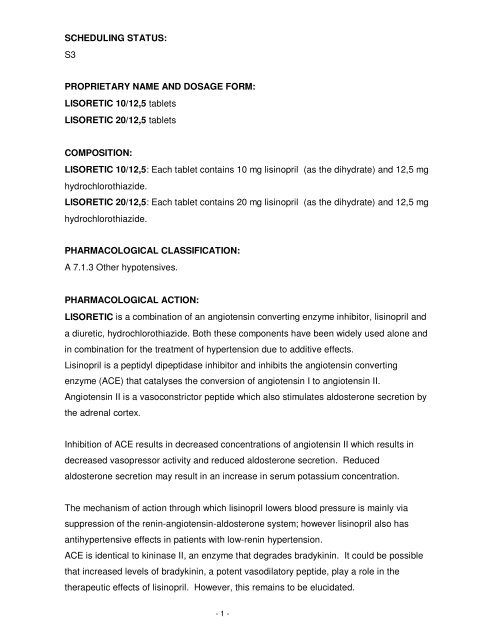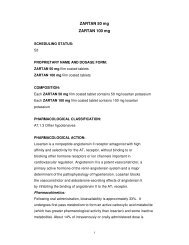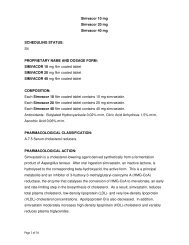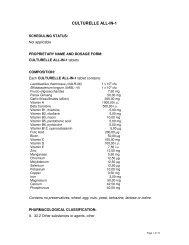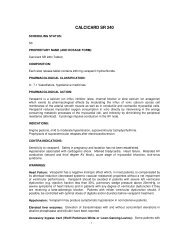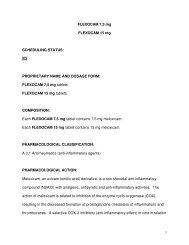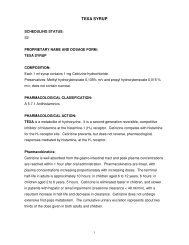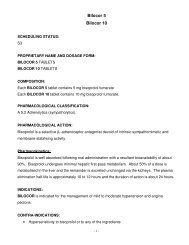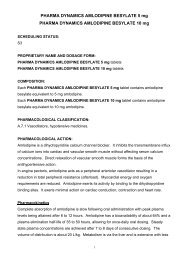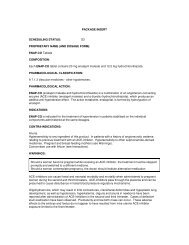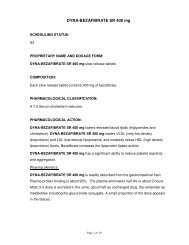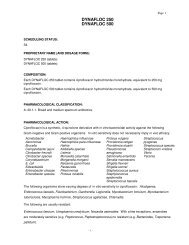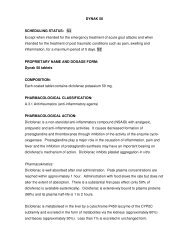LISORETIC 10/12,5 tablets LISORETIC 20/12,5 tablets ...
LISORETIC 10/12,5 tablets LISORETIC 20/12,5 tablets ...
LISORETIC 10/12,5 tablets LISORETIC 20/12,5 tablets ...
Create successful ePaper yourself
Turn your PDF publications into a flip-book with our unique Google optimized e-Paper software.
SCHEDULING STATUS:<br />
S3<br />
PROPRIETARY NAME AND DOSAGE FORM:<br />
<strong>LISORETIC</strong> <strong>10</strong>/<strong>12</strong>,5 <strong>tablets</strong><br />
<strong>LISORETIC</strong> <strong>20</strong>/<strong>12</strong>,5 <strong>tablets</strong><br />
COMPOSITION:<br />
<strong>LISORETIC</strong> <strong>10</strong>/<strong>12</strong>,5: Each tablet contains <strong>10</strong> mg lisinopril (as the dihydrate) and <strong>12</strong>,5 mg<br />
hydrochlorothiazide.<br />
<strong>LISORETIC</strong> <strong>20</strong>/<strong>12</strong>,5: Each tablet contains <strong>20</strong> mg lisinopril (as the dihydrate) and <strong>12</strong>,5 mg<br />
hydrochlorothiazide.<br />
PHARMACOLOGICAL CLASSIFICATION:<br />
A 7.1.3 Other hypotensives.<br />
PHARMACOLOGICAL ACTION:<br />
<strong>LISORETIC</strong> is a combination of an angiotensin converting enzyme inhibitor, lisinopril and<br />
a diuretic, hydrochlorothiazide. Both these components have been widely used alone and<br />
in combination for the treatment of hypertension due to additive effects.<br />
Lisinopril is a peptidyl dipeptidase inhibitor and inhibits the angiotensin converting<br />
enzyme (ACE) that catalyses the conversion of angiotensin I to angiotensin II.<br />
Angiotensin II is a vasoconstrictor peptide which also stimulates aldosterone secretion by<br />
the adrenal cortex.<br />
Inhibition of ACE results in decreased concentrations of angiotensin II which results in<br />
decreased vasopressor activity and reduced aldosterone secretion. Reduced<br />
aldosterone secretion may result in an increase in serum potassium concentration.<br />
The mechanism of action through which lisinopril lowers blood pressure is mainly via<br />
suppression of the renin-angiotensin-aldosterone system; however lisinopril also has<br />
antihypertensive effects in patients with low-renin hypertension.<br />
ACE is identical to kininase II, an enzyme that degrades bradykinin. It could be possible<br />
that increased levels of bradykinin, a potent vasodilatory peptide, play a role in the<br />
therapeutic effects of lisinopril. However, this remains to be elucidated.<br />
- 1 -
Hydrochlorothiazide is a thiazide diuretic and an antihypertensive agent. It affects the<br />
distal renal tubular mechanism of electrolyte re-absorption and increases excretion of<br />
sodium and chloride in approximately equivalent amounts. Natriuresis may be<br />
accompanied by some loss of potassium and bicarbonate. The mechanism of the<br />
antihypertensive effects of the thiazides is unknown. Thiazides do not usually affect<br />
normal blood pressure.<br />
Pharmacokinetics<br />
The concomitant administration of lisinopril and hydrochlorothiazide has no clinical<br />
significant effect on the pharmacokinetics of either drug.<br />
Lisinopril<br />
Approximately 60% of lisinopril is absorbed after oral administration. The absorption<br />
varies between individuals (6 to 60%).<br />
Following oral administration of lisinopril, peak serum concentrations occur within about 7<br />
hours. Lisinopril has an effective half-life of <strong>12</strong> hours. Lisinopril does not bind to other<br />
serum proteins.<br />
The absorption of lisinopril is not affected by the presence of food in the gastrointestinal<br />
tract.<br />
Lisinopril does not undergo metabolism and absorbed drug is excreted unchanged<br />
entirely in the urine. Impaired renal function decreases elimination of lisinopril. This<br />
decrease only becomes clinically important when the glomerular filtration rate is below 30<br />
ml/min. Lisinopril can be removed by dialysis.<br />
Older patients have higher blood levels and higher values for the area under the plasma<br />
concentration time curve than younger patients.<br />
Hydrochlorothiazide<br />
The plasma half-life of hydrochlorothiazide can vary between 5 and 15 hours.<br />
Approximately 60% of the dose is eliminated unchanged within 24 hours.<br />
After oral administration of hydrochlorothiazide, diuresis begins within 2 hours, peaks in<br />
about 4 hours and lasts 6 to <strong>12</strong> hours.<br />
INDICATIONS:<br />
- 2 -
Mild to moderate hypertension in patients who have been stabilized on their individual<br />
components given in the same proportions.<br />
CONTRA-INDICATIONS:<br />
• Anuria.<br />
• Hypersensitivity to any component of this product.<br />
• Patients with a history of angioedema relating to previous treatment with an<br />
angiotensin-converting enzyme inhibitor.<br />
• Patients with hereditary or idiopathic angioedema (see Special Precautions).<br />
• Hypersensitivity to other sulphonamide-derived medicines.<br />
• Pregnancy and Nursing Mothers – see Pregnancy and Lactation.<br />
• Patients with aortic stenosis or hypertrophic cardiomyopathy.<br />
WARNINGS<br />
Pregnancy:<br />
Should a woman become pregnant while receiving an ACE-inhibitor, the treatment must<br />
be stopped immediately and switched to an alternative medicine. Should a woman<br />
contemplate pregnancy, the doctor should institute alternative medication.<br />
ACE-inhibitors can cause foetal and neonatal morbidity and mortality when administered<br />
to pregnant women during the 2 nd and 3 rd trimesters. ACE-inhibitors pass through the<br />
placenta and can be presumed to cause disturbance in foetal blood regulatory<br />
mechanisms.<br />
Use of ACE inhibitors during the second and third trimester has been associated with<br />
foetal and neonatal injury including hypotension, renal failure, hyperkalaemia, oliguria,<br />
anuria and skull hypoplasia in the newborn. Maternal oligohydramnios, presumably<br />
representing decreased foetal renal function, has occurred and may result in limb<br />
contractures, craniofacial deformations and hypoplastic lung development. Prematurity<br />
and low birth mass can occur. These adverse effects to the embryo and foetus do not<br />
appear to have resulted from intrauterine ACE-inhibitor exposure limited to the first<br />
trimester.<br />
Infants whose mothers have taken <strong>LISORETIC</strong> should be closely observed for<br />
hypotension, oliguria and hyperkalaemia. Lisinopril, which crosses the placenta, has<br />
been removed from the neonatal circulation by peritoneal dialysis with some clinical<br />
- 3 -
enefit. There is no experience with the removal of hydrochlorothiazide, which also<br />
crosses the placenta, from the neonatal circulation.<br />
The routine use of diuretics in otherwise healthy pregnant woman is not recommended<br />
and exposes mother and foetus to unnecessary hazard. Diuretics do not prevent<br />
development of toxaemia of pregnancy and there is no satisfactory evidence that they are<br />
useful in the treatment of toxaemia. Thiazides cross the placental barrier and appear in<br />
cord blood. Hazards include foetal or neonatal jaundice, thrombocytopenia and possibly<br />
other adverse reactions which occur in the adult.<br />
Breast-feeding<br />
It is not known whether lisinopril is distributed into human breast milk; however the<br />
thiazides do appear in human milk. If the drug is deemed essential, the patient should<br />
stop nursing.<br />
INTERACTIONS<br />
• Serum Potassium<br />
The decrease in potassium caused by thiazide diuretics is usually potentiated by the<br />
effect of lisinopril. The use of potassium supplements, potassium-sparing agents or<br />
potassium-containing salt substitutes, especially in patients with impaired renal function,<br />
may result in a significant increase in serum potassium. Should it be required to<br />
administer <strong>LISORETIC</strong> concomitantly with any of these agents, caution should be<br />
exercised and serum potassium should be monitored on a regular basis.<br />
• Lithium<br />
The concomitant use of lithium with diuretics or ACE-inhibitors is not indicated. The renal<br />
clearance of lithium is reduced by ACE-inhibitors and diuretic agents and a high risk of<br />
lithium toxicity exists. The prescribing information for lithium preparation should be<br />
reviewed before use of these preparations.<br />
• Non-steroidal anti-inflammatory drugs (NSAIDs)<br />
Indomethacin may decrease the antihypertensive efficacy of <strong>LISORETIC</strong>. In some<br />
patients with compromised renal function who are being treated with non-steroidal anti-<br />
inflammatory drugs (NSAIDs), the co-administration of lisinopril may result in a further<br />
deterioration in renal function.<br />
- 4 -
The administration of a non-steroidal anti-inflammatory agent can reduce the diuretic,<br />
natriuretic and antihypertensive effects of diuretics in some patients.<br />
- 5 -
• Tubocurarine<br />
Thiazides may increase the responsiveness to tubocurarine.<br />
• Other Antihypertensive Agents<br />
Additive effects may occur.<br />
• Alcohol, barbiturates or narcotics<br />
Potentiation of orthostatic hypotension caused by thiazides may occur.<br />
• Antidiabetic medicine (oral agents and insulin)<br />
Dosage adjustment of the antidiabetic medicine may be required with the concomitant use<br />
of a thiazide diuretic.<br />
• Corticosteroids, ACTH<br />
Concomitant use of a thiazide diuretic may intensify electrolyte depletion and<br />
hypokalaemia.<br />
• Pressor Amines (e.g. adrenalin):<br />
Thiazide diuretics may decrease response to pressor amines. This decrease in response<br />
is not sufficient to prelude the use of pressor amines.<br />
PREGNANCY AND LACTATION<br />
Safety in pregnancy and lactation has not been established. Refer to WARNINGS<br />
DOSAGE AND DIRECTIONS FOR USE<br />
The usual dosage is one tablet daily, taken at approximately the same time each day.<br />
It is recommended that if the desired clinical effect cannot be achieved within 2 to 4<br />
weeks with this dosage, the dosage may be increased to a maximum of two <strong>tablets</strong>,<br />
administered once daily.<br />
Prior Treatment with Diuretics<br />
Symptomatic hypotension may occur after the initial dose of <strong>LISORETIC</strong>; this<br />
phenomenon occurs more likely in patients who are volume and/or salt depleted as a<br />
result of prior diuretic therapy. If possible, the diuretic therapy should be discontinued for<br />
2-3 days prior to initiation of therapy with <strong>LISORETIC</strong>, or if this is not possible, lisinopril<br />
should be given alone at a low initial dose of 5 mg.<br />
- 6 -
Renal Impairment<br />
Thiazides may not be suitable diuretics for use in patients with renal impairment and are<br />
ineffective in moderate or severe renal impairment (creatinine clearance values of 30<br />
ml/min or below.)<br />
<strong>LISORETIC</strong> should not be used as initial therapy in any patient with renal insufficiency.<br />
In patients with creatinine clearance of >30 and
Less frequently: dizziness and fatigue, which generally diminish when the dosages<br />
are reduced<br />
Rare: paraesthesia, Asthenia<br />
Hydrochlorothiazide: vertigo, fever<br />
Frequently: restlessness<br />
Lisinopril: vertigo, sleep disturbance, hypoaesthesia<br />
Rare: paraesthesia<br />
Psychiatric<br />
Lisinopril: mood alterations, mental confusion<br />
Musculoskeletal<br />
Lisoretic<br />
Frequently: muscle cramps<br />
Rare: weakness<br />
Hydrochlorothiazide<br />
Frequently: muscle spasm<br />
Hepato-biliary<br />
Hydrochlorothiazide: hyperglycaemia, glycosuria<br />
Rare: jaundice (intrahepatic cholestatic jaundice), pancreatitis, hyperuricaemia<br />
Lisinopril: hepatitis (hepatocellular or cholestatic)<br />
Respiratory<br />
Lisoretic<br />
Frequently: dry cough<br />
Hydrochlorothiazide: respiratory distress including pneumonitis and pulmonary oedema,<br />
anaphylactic reactions.<br />
Lisinopril: bronchospasm, rhinitis, sinusitis, pulmonary infiltrates<br />
Cardiac<br />
Lisoretic<br />
Rare: palpitation, chest discomfort<br />
Lisinopril<br />
- 8 -
Rare: myocardial infarction or cerebrovascular accident possibly secondary<br />
Vascular<br />
Lisoretic<br />
to excessive hypotension in high risk patients (see Special<br />
Precautions), tachycardia<br />
Less frequently: hypotension including orthostatic hypotension.<br />
Hydrochlorothiazide: necrotizing angiitis (vasculitis) (cutaneous vasculitis)<br />
Renal and urinary<br />
Hydrochlorothiazide<br />
Rare: renal failure, renal dysfunction and interstitial nephritis.<br />
Lisinopril: diaphoresis, uraemia, oliguria/anuria, renal dysfunction, acute renal<br />
Skin and appendages<br />
Lisoretic<br />
failure<br />
Less frequently: rash<br />
Rare: photosensitivity<br />
Hydrochlorothiazide: purpura<br />
Less frequently: photosensitivity<br />
Rare: urticaria<br />
Lisinopril: psoriasis and severe skin disorders, including pemphigus, toxic<br />
Less frequently: pruritus<br />
Rare: urticaria<br />
Blood and lymphatic system<br />
epidermal necrolysis, erythema multiforme, alopecia<br />
Hydrochlorothiazide: leucopoenia, aplastic anaemia, haemolytic anaemia<br />
Rare: agranulocytosis, thrombocytopenia<br />
Lisinopril<br />
Less frequently: haemolytic anaemia<br />
Eye<br />
Hydrochlorothiazide: xanthopsia, transient blurred vision<br />
- 9 -
Metabolism and nutrition<br />
Lisoretic<br />
Rare: gout<br />
Hydrochlorothiazide<br />
Frequently: electrolyte imbalance including hyponatraemia<br />
Less frequently: anorexia<br />
Lisinopril: taste disturbances, hyponatraemia<br />
Endocrine<br />
Hydrochlorothiazide: sialoadenitis<br />
Reproductive system<br />
Lisoretic<br />
Less frequently: impotence<br />
Hypersensitivity Reactions<br />
Lisoretic<br />
Rare: Angioedema of the face, extremities, lips, tongue, glottis and/or larynx has<br />
been reported (see Contra-Indications & Special Precautions). A symptom<br />
complex has been reported which may include fever, vasculitis, myalgia,<br />
arthralgia/arthritis, a positive Antinuclear antibody (ANA), elevated<br />
erythrocyte sedimentation rate, eosinophilia and leukocytosis.<br />
Lisinopril: Stevens-Johnson Syndrome<br />
Laboratory Test Findings<br />
Lisoretic<br />
Hyperkalaemia, hyperglycaemia and hyperuricaemia and have been noted. Increases in<br />
serum creatinine and in blood urea nitrogen have been reported in patients without renal<br />
impairment. These are usually reversible if medication is discontinued.<br />
Bone marrow depression manifesting as anaemia and/or thrombocytopenia and/or<br />
leucopenia have also occurred. Agranulocytosis has been reported.<br />
- <strong>10</strong> -
Small decreases in hemoglobin and haematocrit have been reported frequently in<br />
hypertensive patients treated with <strong>LISORETIC</strong> but were rarely of clinical significance<br />
unless another cause of anaemia was also present.<br />
Elevations of liver enzymes (AST and ALT) and/or serum bilirubin have been reported.<br />
Special Precautions<br />
Hypotension and Electrolyte/Fluid Imbalance<br />
Symptomatic hypotension may occur in the patients with the following: fluid or electrolyte<br />
imbalance, e.g. volume depletion, hyponatraemia, hypochloraemic alkalosis,<br />
hypomagnesaemia or hypokalaemia which may occur from prior treatment with diuretics,<br />
a salt restricted diet, dialysis, or after severe diarrhoea and repeated vomiting.<br />
Determination of serum electrolytes should be performed at appropriate intervals in such<br />
patients.<br />
Initiation of treatment and dose adjustment should be monitored under close medical<br />
supervision in patients with an increased risk of symptomatic hypotension. Special<br />
consideration should be given when this medication is administered to patients with<br />
ischemic heart or cerebrovascular disease as an excessive decrease in blood pressure<br />
could result in a myocardial infarction or cerebrovascular accident.<br />
If hypotension occurs, the patient should be placed in the supine position and, if<br />
necessary, should receive an intravenous infusion of 0,9% saline. A transient<br />
hypotensive response does not warrant discontinuation of further doses.<br />
Once effective blood volume and pressure have been stabilised, therapy at a reduced<br />
dosage may be reinstituted; or alternatively either of the components may be used<br />
appropriately as mono therapy.<br />
Renal Insufficiency<br />
Thiazides may not be suitable diuretics for use in patients with renal impairment and are<br />
ineffective at creatinine clearance values of 30 ml/min or below (i.e. moderate or severe<br />
renal insufficiency.)<br />
<strong>LISORETIC</strong> should not be administered to patients with a creatinine clearance ≤ 80<br />
ml/min until titration of the individual components has shown the need for the doses<br />
present in <strong>LISORETIC</strong>.<br />
In some patients with bilateral renal artery stenosis or stenosis of the artery to a solitary<br />
kidney, who have received ACE inhibitor treatment, increases in blood urea and serum<br />
- 11 -
creatinine, usually reversible upon discontinuation of therapy, have been seen. This is<br />
especially likely to occur in patients with renal insufficiency.<br />
Some hypertensive patients with no apparent pre-existing renal disease have developed<br />
increases in blood urea and serum creatinine when lisinopril has been given<br />
concomitantly with a diuretic. If this occurs during therapy with <strong>LISORETIC</strong>, it should be<br />
discontinued. Reinstitution of therapy at a reduced dosage may be possible: or either of<br />
the components may be used alone as appropriate.<br />
Haemodialysis<br />
The use of <strong>LISORETIC</strong> is not indicated in patients requiring dialysis for renal failure.<br />
Anaphylactoid reactions have been reported in patients undergoing haemodialysis<br />
procedures with certain dialysis membranes (e.g. with the high-flux membranes AN 69)<br />
and concurrent treatment with an ACE-inhibitor. Consideration to the use of a different<br />
type of dialysis membrane or a different class of antihypertensive agent should be given<br />
in these patients.<br />
Hepatic Disease<br />
Caution should be exercised when thiazides are used in patients with hepatic impairment<br />
or progressive liver disease, as minor alterations of fluid and electrolyte balance may<br />
precipitate hepatic coma in these patients.<br />
Surgery/Anaesthesia<br />
In patients undergoing major surgery or during anaesthesia with agents that produce<br />
hypotension, lisinopril may block angiotensin II formation secondary to compensatory<br />
renin release. Should hypotension occur, and is considered to be due to this mechanism,<br />
it can be corrected by volume expansion.<br />
Metabolic and Endocrine Effects<br />
Thiazide diuretics may impair glucose tolerance. Dosage adjustment of antidiabetic<br />
agents, including insulin, may be required.<br />
Decreased urinary calcium excretion caused by thiazides may result in intermittent and a<br />
slightly raised serum calcium concentration. Should marked hypercalcaemia occur, it<br />
may be evidence of underlying hyperparathyroidism. <strong>LISORETIC</strong> therapy should be<br />
discontinued before carrying out tests for parathyroid function (see Interactions).<br />
Increased cholesterol and triglyceride levels may be a result of thiazide diuretic therapy.<br />
- <strong>12</strong> -
Thiazide diuretics may precipitate hyperuricaemia and/or gout in certain patients. Due to<br />
the increase in urinary uric acid caused by lisinopril, hyperuricaemia may be attenuated<br />
by <strong>LISORETIC</strong> which contains both components.<br />
Sensitivity/Angioedema<br />
Angioedema of the face, extremities, lips, tongue, glottis and/or larynx has been reported<br />
in patients with angiotensin-converting enzyme inhibitors, including lisinopril. In such<br />
cases <strong>LISORETIC</strong> should be discontinued immediately and appropriate measures should<br />
be instituted to ensure complete resolution of symptoms prior to dismissing the patient. In<br />
instances where swelling has been confined only to the face and lips, the condition<br />
usually resolves without treatment, although antihistamines have been useful in relieving<br />
symptoms.<br />
Angioedema associated with laryngeal oedema may be fatal. Where there is involvement<br />
of the tongue, glottis or larynx, likely to cause airway obstruction, appropriate emergency<br />
therapy should be administered promptly. This may include the administration of<br />
adrenaline and/or maintenance of a patient airway. The patient should be under close<br />
medical supervision until complete and sustained resolution of symptoms has occurred.<br />
These patients should never receive any ACE-inhibitor again.<br />
Patients with a history of angioedema unrelated to ACE-inhibitor therapy may be at<br />
increased risk of angioedema while receiving an ACE-inhibitor (see also Contra-<br />
indications).<br />
In patients receiving thiazides, sensitivity reactions may occur with or without a history of<br />
allergy or bronchial asthma. Exacerbation or activation of systemic lupus erythematosus<br />
has been reported with the use of thiazides.<br />
Race<br />
<strong>LISORETIC</strong> causes a higher rate of angioedema in black patients than in non-black<br />
patients.<br />
Desensitisation<br />
Patients receiving ACE-inhibitors during desensitisation treatment (e.g. hymenoptera<br />
venom) have sustained anaphylactoid reactions. These reactions have been avoided<br />
- 13 -
when ACE-inhibitors were temporarily withheld but they reappeared upon inadvertant<br />
rechallenge.<br />
Cough<br />
A non-productive, persistent cough has been reported with the use of ACE-inhibitors. The<br />
cough resolves after discontinuation of therapy. ACE-inhibitor-induced cough should be<br />
considered as part of the differential diagnose of cough.<br />
KNOWN SYMPTOMS OF OVERDOSAGE AND PARTICULARS OF ITS TREATMENT:<br />
Treatment is symptomatic and supportive. No specific information is available on the<br />
treatment of overdosage with <strong>LISORETIC</strong>. Therapy with <strong>LISORETIC</strong> should be<br />
discontinued and the patient should be kept under very close supervision. Suggested<br />
measures include induction of emesis and/or gastric lavage, if ingestion is recent, and<br />
correction of dehydration, electrolyte imbalance and hypotension by established<br />
procedures.<br />
Lisinopril: The most likely features of overdosage may include hypotension, electrolyte<br />
disturbance and renal failure. Treatment is symptomatic and supportive.<br />
Hydrochlorothiazide: The most common signs and symptoms observed are those caused<br />
by electrolyte depletion (hypokalaemia, hypochloraemia, hyponatraemia) and dehydration<br />
resulting from excessive diuresis. If digitalis has been used concomitantly, hypokalaemia<br />
may accentuate cardiac arrhythmias.<br />
IDENTIFICATION:<br />
<strong>LISORETIC</strong> <strong>10</strong>/<strong>12</strong>,5 : A peach coloured, round, uncoated, 6 mm biconvex tablet., marked ‘LH’.<br />
<strong>LISORETIC</strong> <strong>20</strong>/<strong>12</strong>,5 : A white coloured, round, uncoated, 8 mm biconvex scored tablet., marked<br />
“LH’’.<br />
PRESENTATION:<br />
PVC/PVDC Aluminium blister packs of 30 <strong>tablets</strong>.<br />
STORAGE INSTRUCTIONS:<br />
Store below 25ºC. Protect from light.<br />
Do not remove blister from the carton until required for use.<br />
KEEP OUT OF REACH OF CHILDREN.<br />
REGISTRATION NUMBERS:<br />
- 14 -
<strong>LISORETIC</strong> <strong>10</strong>/<strong>12</strong>,5 : 37/7.1.3/0475<br />
<strong>LISORETIC</strong> <strong>20</strong>/<strong>12</strong>,5 : 37/7.1.3/0476<br />
NAME AND BUSINESS ADDRESS OF THE HOLDER OF THE CERTIFICATE OF<br />
REGISTRATION:<br />
Pharma Dynamics Pty (Ltd)<br />
F02 Grapevine House<br />
Steenberg Office Park<br />
Westlake<br />
7945<br />
DATE OF PUBLICATION OF THIS PACKAGE INSERT: 8 October <strong>20</strong>04<br />
- 15 -
SKEDULERINGSTATUS:<br />
S3<br />
EIENDOMSNAAM EN DOSEERVORM:<br />
<strong>LISORETIC</strong> <strong>10</strong>/<strong>12</strong>,5 tablette<br />
<strong>LISORETIC</strong> <strong>20</strong>/<strong>12</strong>,5 tablette<br />
SAMESTELLING:<br />
<strong>LISORETIC</strong> <strong>10</strong>/<strong>12</strong>,5: Elke tablet bevat <strong>10</strong> mg lisinopriel (as die dihidraat) en <strong>12</strong>,5 mg<br />
hidrochloortiasied.<br />
<strong>LISORETIC</strong> <strong>20</strong>/<strong>12</strong>,5: Elke tablet bevat <strong>20</strong> mg lisinopriel (as die dihidraat) en <strong>12</strong>,5 mg<br />
hidrochloortiasied.<br />
FARMAKOLOGIESE KLASSIFISERING:<br />
A.7.1.3 Ander hipotensiewe middels.<br />
FARMAKOLOGIESE WERKING<br />
<strong>LISORETIC</strong> is 'n kombinasie van 'n angiotensienomsettingsensiem-inhibeerder, lisinopriel<br />
en 'n diuretikum, hidrochloortiasied. Beide hierdie komponente is wyd op hul eie en in<br />
kombinasie gebruik vir die behandeling van hipertensie as gevolg van additiewe<br />
uitwerkings.<br />
Lisinopriel is 'n peptidieldipeptidase-inhibeerder en inhibeer die<br />
angiotensienomsettingsensiem(AOE) wat die omsetting van angiotensien I na<br />
angiotensien II kataliseer.<br />
Angiotensien II is 'n vatvernouende peptied wat ook aldosteroonafskeiding deur die<br />
adrenale korteks stimuleer.<br />
Inhibisie van AOE veroorsaak verminderde konsentrasies van angiotensien II wat weer<br />
verminderde vasopressoraktiwiteit en verminderde aldosteroonafskeiding veroorsaak.<br />
Verminderde aldosteroonafskeiding mag 'n verhoging in serumkaliumkonsentrasie<br />
veroorsaak.<br />
Die meganisme van werking waardeur lisinopriel bloeddruk verlaag, is hoofsaaklik deur<br />
onderdrukking van die renien-angiotensien-aldosteroonsisteem; lisinopriel het egter ook<br />
antihipertensiewe uitwerkings in pasiënte met lae-renien-hipertensie.<br />
- 16 -
AOE is identies aan kininase II, 'n ensiem wat bradikinien afbreek. Dit is moontlik dat<br />
verhoogde vlakke van bradikinien, 'n kragtige vasodilatasie peptied, 'n rol mag speel in<br />
die terapeutiese uitwerkings van lisinopriel. Dit moet egter nog opgeklaar word.<br />
Hidrochloortiasied is 'n tiasied-diuretikum en 'n antihipertensiewe middel. Dit beïnvloed<br />
die distale nierbuisie-meganisme van elektrolietherabsorpsie en verhoog uitskeiding van<br />
natrium en chloried in ongeveer ekwivalente hoeveelhede. Natriurese mag deur 'n sekere<br />
mate van verlies aan kalium en bikarbonaat vergesel word. Die meganisme van die<br />
antihipertensiewe uitwerking van die tiasiede is onbekend. Tiasiede het gewoonlik geen<br />
invloed op normale bloeddruk nie.<br />
Farmakokinetika<br />
Die gelyktydige toediening van lisinopriel en hidrochloortiasied het geen klinies<br />
beduidende uitwerking op die farmakokinetika van beide geneesmiddels nie.<br />
Lisinopriel<br />
Ongeveer 60% van lisinopriel word na orale toediening geabsorbeer. Die absorpsie<br />
wissel tussen individue (6 tot 60%).<br />
Na orale toediening van lisinopriel word piek serumkonsentrasies binne ongeveer 7 uur<br />
bereik. Lisinopriel het 'n effektiewe halfleeftyd van <strong>12</strong> uur. Lisinopriel bind nie aan ander<br />
serumproteïene nie.<br />
Die absorpsie van lisinopriel word nie deur die teenwoordigheid van voedsel in die<br />
spysverteringskanaal beïnvloed nie.<br />
Lisinopriel word nie gemetaboliseer nie en al die geabsorbeerde geneesmiddel word<br />
onveranderd in die urine uitgeskei. Ingekorte nierfunksie verminder eliminasie van<br />
lisinopriel. Hierdie vermindering word alleenlik kliniese belangrik wanneer die glomerulêre<br />
filtrasietempo tot onder 30 ml/min daal. Lisinopriel kan deur dialise verwyder word.<br />
Ouer pasiënte het hoër bloedvlakke en hoër waardes vir die area onder die<br />
plasmakonsentrasie-tydkurwe as jonger pasiënte.<br />
Hidrochloortiasied<br />
Die plasma halfleeftyd van hidrochloortiasied kan tussen 5 en 15 uur wissel. Ongeveer<br />
60% van die dosis word binne 24 uur onveranderd uitgeskei. Na orale toediening van<br />
hidrochloortiasied begin diurese binne 2 uur, piek vlakke word na ongeveer 4 uur bereik<br />
- 17 -
en duur vir 6 tot <strong>12</strong> uur voort.<br />
INDIKASIES<br />
Ligte tot matige hipertensie in pasiënte wat gestabiliseer is op die individuele<br />
komponente wat teen dieselfde verhoudings toegedien is.<br />
KONTRA-INDIKASIES<br />
• Anurie.<br />
• Hipersensitiwiteit teenoor enige bestanddeel van hierdie produk.<br />
• Pasiënte met 'n geskiedenis van angio-edeem verwant aan vorige behandeling met 'n<br />
angiotensienomsettingsensiem-inhibeerder.<br />
• Pasiënte met aangebore of idiopatiese angio-edeem (sien Spesiale<br />
Voorsorgmaatreëls).<br />
• Hipersensitiwiteit teenoor ander sulfonamied-afgeleide medisyne.<br />
• Swangerskap en Borsvoedende Moeders - sien Swangerskap en Laktasie.<br />
• Pasiënte met stenose van die aorta of hipertrofiese kardiomiopatie.<br />
WAARSKUWINGS<br />
Swangerskap:<br />
Indien 'n vrou sou swanger word terwyl sy 'n AOE-inhibeerder ontvang, moet die<br />
behandeling onmiddellik gestaak word en na 'n alternatiewe medisyne verander word.<br />
Indien 'n vrou swangerskap sou oorweeg, moet die geneesheer alternatiewe<br />
medikasie instel.<br />
AOE-inhibeerders kan fetale en neonatale morbiditeit en mortaliteit veroorsaak as dit aan<br />
swanger vrouens tydens die 2de en 3de semester toegedien word. AOE-inhibeerders<br />
beweeg oor die plasenta en daar kan aanvaar word dat dit versteurings in fetale<br />
bloedbeheermeganismes veroorsaak.<br />
Gebruik van AOE-inhibeerders tydens die tweede en derde trimester is met fetale en<br />
neonatale besering, insluitend hipotensie, nierversaking, hiperkalemie, oligurie, anurie en<br />
skedel hipoplasie in die pasgeborene, geassosieer. Oligohidramnios van die moeder, wat<br />
waarskynlik verminderde fetale nierfunksie verteenwoordig, het voorgekom en mag<br />
kontraktuur van ledemate, wanvorming van die skedel en gesig, en hipoplastiese<br />
longontwikkeling veroorsaak. Prematuriteit en lae massa by geboorte kan voorkom. Dit<br />
wil voorkom dat hierdie nadelige uitwerkings ten opsigte van die embrio en fetus nie deur<br />
- 18 -
lootstelling aan 'n AOE-inhibeerder in die baarmoeder wat tot die eerste trimester<br />
beperk is, veroorsaak word nie.<br />
Suigelinge van moeders wat <strong>LISORETIC</strong> geneem het, moet versigtig vir hipotensie,<br />
oligurie en hiperkalsemie dopgehou word. Lisinopriel wat die plasenta oorsteek, is van<br />
die neonatale sirkulasie met 'n mate van kliniese voordeel deur peritoneale dialise<br />
verwyder. Daar bestaan geen ondervinding met die verwydering van hidrochloortiasied,<br />
wat ook oor die plasenta beweeg, uit die neonatale bloedsomloop nie.<br />
Die roetine gebruik van diuretika in andersins gesonde swanger vrouens word nie<br />
aanbeveel nie en stel die moeder en fetus aan onnodige gevare bloot. Diuretika verhoed<br />
nie die ontwikkeling van toksemie van swangerskap en daar is geen bevredigende<br />
bewyse dat hulle vir die behandeling van toksemie nuttig is nie. Tiasiede beweeg oor die<br />
skans van die plasenta en word in koordbloed aangetref. Gevare sluit in fetale of<br />
neonatale geelsug, trombositopenie en moontlik ook ander nadelige reaksies wat by<br />
volwassenes voorkom.<br />
Borsvoeding<br />
Dit is nie bekend of lisinopriel in menslike borsmelk versprei word nie; tiasiede word egter<br />
in menslike melk aangetref. Indien die geneesmiddel as essensieel beskou word, moet<br />
die pasiënt borsvoeding staak.<br />
INTERAKSIES<br />
• Serumkalium<br />
Die vermindering in kalium veroorsaak deur tiasied-diuretika word gewoonlik deur die<br />
uitwerking van lisinopriel versterk. Die gebruik van kaliumsupplemente, kaliumsparende<br />
middels of kalium-bevattende soutvervangers, veral in pasiënte met ingekorte nierfunksie,<br />
mag 'n beduidende verhoging in serumkalium veroorsaak. Indien dit nodig is om<br />
<strong>LISORETIC</strong> saam met enigeen van hierdie middels toe te dien, moet omsigtigheid<br />
uitgeoefen en serumkalium gereeld gemoniteer word.<br />
• Litium<br />
Die gelyktydige gebruik van litium saam met diuretika of AOE-inhibeerders word nie<br />
aangedui nie. Nieropruiming van litium word deur AOE-inhibeerders en diuretika<br />
verminder en daar bestaan 'n hoë risiko van litiumtoksisiteit. Die inligting vir die voorskryf<br />
van litiumpreparate moet nagegaan word voordat hierdie preparate gebruik word.<br />
- 19 -
• Nie-steroïedale anti-inflammatoriese middels (NSAIMs)<br />
Indometasien mag die antihipertensiewe doeltreffendheid van <strong>LISORETIC</strong> verminder. In<br />
sommige pasiënte met gekompromitteerde nierfunksie wat met nie-steroïedale anti-<br />
inflammatoriese middels (NSAIMs) behandel word, mag die gelyktydige toediening van<br />
lisinopriel addisionele verslegting van nierfunksie veroorsaak.<br />
Die toediening van 'n nie-steroïedale anti-inflammatoriese middel kan die diuretiese,<br />
natriuretiese en antihipertensiewe uitwerkings van diuretika in sommige pasiënte<br />
verminder.<br />
• Tubokurarien<br />
Tiasiede mag die reaksie op tubokurarien verhoog.<br />
• Ander Antihipertensiewe Middels<br />
Additiewe uitwerkings mag voorkom.<br />
• Alkohol, barbiturate of dwelmmiddels<br />
Potensiëring van ortostatiese hipotensie veroorsaak deur tiasiede mag voorkom.<br />
• Antidiabetiese medisyne (orale middels en insulien)<br />
Dosisaanpassing van die antidiabetiese medisyne mag nodig wees wanneer 'n tiasied-<br />
diuretikum gelyktydige gebruik word.<br />
• Kortikosteroïede, ACTH<br />
Gelyktydige gebruik van 'n tiasied-diuretikum mag elektrolietuitputting en hipokalemie<br />
vererger.<br />
• Pressoramiene (bv. adrenalien)<br />
Tiasied-diuretika mag die reaksie op pressoramiene verminder. Hierdie vermindering van<br />
die reaksie is nie voldoende om die gebruik van pressoramiene uit te sluit nie.<br />
SWANGERSKAP EN LAKTASIE<br />
Veiligheid in swangerskap en laktasie is nie vasgestel nie. Verwys na WAARSKUWINGS.<br />
- <strong>20</strong> -
DOSERING EN GEBRUIKSAANWYSINGS<br />
Die gewone dosis is een tablet per dag, wat altyd op ongeveer dieselfde tyd van die dag<br />
geneem word. As die gewenste kliniese uitwerking nie binne 2 tot 4 weke bereik kan word<br />
nie, word dit aanbeveel dat die dosering tot 'n maksimum van twee tablette wat een keer<br />
per dag toegedien word, verhoog word.<br />
Voorige Behandeling met Diuretika<br />
Simptomatiese hipotensie mag na die eerste dosis van <strong>LISORETIC</strong> voorkom; hierdie<br />
verskynsel is meer geneig om te gebeur in pasiënte wat ly aan volume- en/of<br />
soutuitputting as gevolg van vorige diuretiese behandeling. Indien moontlik, moet die<br />
diuretiese terapie vir 2-3 dae voor instelling van terapie met <strong>LISORETIC</strong> gestaak word, of<br />
as dit nie moontlik is nie, behoort lisinopriel alleen teen 'n lae aanvangsdosis van 5 mg<br />
gegee te word.<br />
Nierinkorting<br />
Tiasiede mag nie geskikte diuretika wees vir gebruik in pasiënte met nierinkorting en is in<br />
matige tot ernstige nierinkorting (kreatinienopruimingwaardes van 30 ml/min of laer), nie<br />
effektief nie.<br />
<strong>LISORETIC</strong> behoort nie as aanvangsterapie gebruik te word in enige pasiënt met<br />
nierinkorting nie. <strong>LISORETIC</strong> kan in pasiënte met kreatienopruiming van >30 en
Gastroïntestinaal<br />
Lisoretic<br />
Minder frekwent: diarree<br />
Seldsaam: naarheid, braking<br />
Hidrochloortiasied<br />
Minder frekwent: gastriese irritasie, hardlywigheid<br />
Lisinopriel<br />
Seldsaam: abdominale pyn en swak spysvertering<br />
Senusisteem<br />
Lisoretic<br />
Frekwent: hoofpyn, droë mond<br />
Minder frekwent: duiseligheid en moegheid, wat meestal verminder as die doserings<br />
verlaag word<br />
Seldsaam: parestesie, astenie<br />
Hidrochloortiasied: vertigo, koors<br />
Frekwent: rusteloosheid<br />
Lisinopriel: vertigo, slaapversteurings, hipoëstesie<br />
Seldsaam: parestesie<br />
Psigiatries<br />
Lisinopriel: veranderings van humeur, geestesverwarring<br />
Muskuloskeletaal<br />
Lisoretic<br />
Frekwent: spierkrampe<br />
Seldsaam: swakheid<br />
Hidrochloortiasied<br />
Frekwent: spierspasma<br />
Hepatobiliêr<br />
Hidrochloortiasied: hiperglisemie, glikosurie<br />
Seldsaam: geelsug (intrahepatiese cholestatiese geelsug), pankreatitis,<br />
hiperurisemie<br />
- 22 -
Lisinopriel: hepatitis (hepatosellulêr of cholestaties)<br />
Respiratories<br />
Lisoretic<br />
Frekwent: droë hoes<br />
Hidrochloortiasied: respiratoriese nood, insluitend pneumonitis en pulmonale edeem,<br />
anafilaktiese reaksies<br />
Lisinopriel: brongospasma , rinitis, sinusitis, pulmonale infiltrate<br />
Kardiaal<br />
Lisoretic<br />
Seldsaam: hartkloppings, borsongemak<br />
Lisinopriel<br />
Seldsaam: miokardiale infarksie of serebrovaskulêre insident moontlik sekondêr<br />
Vaskulêr<br />
Lisoretic<br />
tot oormatige hipotensie in hoë-risiko pasiënte (sien Spesiale<br />
Voorsorgmaatreëls), tagikardie<br />
Minder frekwent: hipotensie, insluitend ortostatiese hipotensie.<br />
Hidrochloortiasied: nekrotiserende angeïtis (vaskulitis) (vaskulitis van die vel)<br />
Renaal en urinêr<br />
Hidrochloortiasied:<br />
Seldsaam: nierversaking, nierdisfunksie en interstisiële nefritis.<br />
Lisinopriel: diaforese, uremie, oligurie/anurie, nierdisfunksie, akute<br />
Vel en aanhangsels<br />
Lisoretic<br />
nierversaking.<br />
Minder frekwent: veluitslag<br />
Seldsaam: fotosensitiwiteit<br />
Hidrochloortiasied: purpura<br />
Minder frekwent: fotosensitiwiteit<br />
Seldsaam: urtikarie<br />
Lisinopriel: psoriase en ernstige velsiektes, insluitend pemfigus, toksiese<br />
- 23 -
Minder frekwent: pruritus<br />
Seldsaam: urtikarie<br />
Bloed en limfatiese sisteem<br />
epidermale nekrolise, erythema multiforme, alopesie<br />
Hidrochloortiasied: leukopenie, aplastiese anemie, hemolitiese anemie<br />
Seldsaam: agranulositose, trombositopenie<br />
Lisinopriel:<br />
Minder frekwent: hemolitiese anemie<br />
Oog<br />
Hidrochloortiasied: xantopsie, verbygaande versteurde visie<br />
Metabolisme en voeding<br />
Lisoretic:<br />
Seldsaam: jig<br />
Hidrochloortiasied:<br />
Frekwent: elektrolietwanbalans, insluitend hiponatremie<br />
Minder frekwent: anoreksie<br />
Lisinopriel: smaakversteurings, hiponatremie<br />
Endokrien<br />
Hidrochloortiasied: sialadenitis<br />
Voortplantingsisteem<br />
Lisoretic<br />
Minder frekwent: impotensie<br />
Hipersensitiwiteitsreaksies<br />
Lisoretic<br />
Seldsaam: Angio-edeem van die gesig, ekstremiteite, lippe, tong, glottis en/of larinks is<br />
aangemeld (sien Kontra-indikasies en Spesiale Voorsorgmaatreëls). 'n<br />
Simptoomkompleks is aangemeld wat koors, vaskulitis, mialgie, artralgie/<br />
artritis, 'n positiewe Anti-nukleêre teenliggaampie (ANA), verhoogde<br />
eritrosiet sedimentasietempo, eosinofilie en leukositose mag insluit.<br />
Lisinopriel: Stevens-Johnson Sindroom<br />
- 24 -
Laboratoriumtoetsbevindings<br />
Lisoretic<br />
Hiperkalemie, hiperglisemie en hiperurisemie is aangemeld. Verhogings in<br />
serumkreatinien en in bloedureumstikstof is aangemeld in pasiënte sonder nierinkorting.<br />
Hierdie simptome is gewoonlik omkeerbaar as die medikasie gestaak word.<br />
Beenmurgonderdrukking wat manifesteer as anemie en/of trombositopenie en/of<br />
leukopenie het ook voorgekom. Agranulositose is gerapporteer.<br />
Klein verlagings in hemoglobien en hematokrit is dikwels aangemeld in hipertensiewe<br />
pasiënte wat met <strong>LISORETIC</strong> behandel is, maar tensy ander oorsake van anemie ook<br />
teenwoordig was, was dit selde van kliniese betekenis.<br />
Verhogings van lewerensieme (AST en ALT) en/of serumbilirubien is aangemeld.<br />
Spesiale Voorsorgmaatreëls:<br />
Hipotensie en Elektroliet-/Vloeistofwanbalans<br />
Simptomatiese hipotensie mag voorkom in pasiënte met die volgende: vloeistof- of<br />
elektrolietwanbalans, bv. volume-uitputting, hiponatremie, hipochloremiese alkalose,<br />
hipomagnesemie, of hipokalemie wat mag voorkom as gevolg van vorige behandeling<br />
met diuretika, 'n soutbeperkte dieet, dialise, of na ernstige diarree en herhaalde braking.<br />
Bepaling van serumelektroliete moet met geskikte tussenposes in sulke pasiënte<br />
uitgevoer word.<br />
In pasiënte met 'n verhoogde risiko van simptomatiese hipotensie behoort die begin van<br />
behandeling en dosisaanpassing onder noukeurige mediese toesig gemoniteer te word.<br />
Spesiale aandag behoort gegee te word wanneer hierdie medikasie aan pasiënte met<br />
iskemiese hart- of serebrovaskulêre siekte toegedien word omdat 'n buitensporige<br />
verlaging in bloeddruk miokardiale infarksie of serebrovaskulêre insidente mag<br />
veroorsaak.<br />
Indien hipotensie voorkom, behoort die pasiënt op die naat van sy/haar rug geplaas te<br />
word en, indien nodig, behoort 'n intraveneuse infusie van 0,9% soutoplossing toegedien<br />
te word. 'n Verbygaande hipotensiewe reaksie noodsaak nie staking van daaropvolgende<br />
dosisse nie.<br />
Sodra effektiewe bloedvolume en -druk gestabiliseer is, kan terapie teen 'n verminderde<br />
dosering weer ingestel word; of as alternatief kan iedereen van die komponente toepaslik<br />
- 25 -
as monoterapie gebruik word.<br />
Nierontoereikendheid<br />
Tiasiede mag nie geskikte diuretika wees vir gebruik in pasiënte met nierinkorting, en by<br />
kreatinienopruimingwaardes van 30 ml/min of laer (d.i. matige tot ernstige<br />
nierontoereikendheid), is dit nie effektief nie.<br />
<strong>LISORETIC</strong> behoort nie aan pasiënte met 'n kreatinienopruiming ≤ 80 ml/min toegedien<br />
te word, totdat titrasie van die individuele komponente die noodsaaklikheid vir die dosisse<br />
wat in <strong>LISORETIC</strong> teenwoordig is, aangetoon het nie.<br />
In sommige pasiënte met bilaterale stenose van die renale arterie of stenose van die<br />
arterie wat 'n enkele nier voorsien, wat AOE-inhibeerderterapie ontvang het, is<br />
verhogings in bloedureum en serumkreatinien waargeneem wat gewoonlik na staking van<br />
terapie omkeerbaar was. Dit sal veral in pasiënte met nierontoereikendheid voorkom.<br />
Sommige hipertensiewe pasiënte met geen duidelike vooraf-bestaande niersiekte het<br />
verhogings in bloedureum en serumkreatinien ontwikkel toe lisinopriel saam met 'n<br />
diuretikum toegedien is. Indien dit tydens terapie met <strong>LISORETIC</strong> voorkom, behoort dit<br />
gestaak te word. Hervatting van terapie teen 'n verminderde dosering mag moontlik wees;<br />
of iedereen van die komponente mag soos toepaslik alleen gebruik word.<br />
Hemodialise<br />
Die gebruik van <strong>LISORETIC</strong> is nie aangedui in pasiënte wat dialise vir nierversaking<br />
benodig nie. Anafilaktoïed reaksies is aangemeld in pasiënte wat hemodialise prosedures<br />
met sekere dialise membrane (bv. met hoë-vloei membrane AN 69) en gelyktydige<br />
behandeling met 'n AOE-inhibeerder, ondergaan. Daar moet oorweging geskenk word om<br />
'n ander soort dialise membraan te gebruik, of 'n ander klas van antihipertensiewe middel<br />
behoort aan hierdie pasiënte gegee te word.<br />
Hepatiese Siekte<br />
Omsigtigheid moet uitgeoefen word wanneer tiasiede in pasiënte met hepatiese inkorting<br />
of progressiewe lewersiekte gebruik word, omdat klein veranderings in vloeistof- en<br />
elektrolietbalans hepatiese koma in hierdie pasiënte mag presipiteer.<br />
Chirurgie/Narkose<br />
In pasiënte wat groot operasies ondergaan of tydens narkose met middels wat hipotensie<br />
veroorsaak, mag lisinopriel angiotensien II formasie sekondêr tot kompensatoriese<br />
- 26 -
vrystelling van renien blokkeer. Indien hipotensie sou voorkom en daar geglo word dat dit<br />
deur hierdie meganisme veroorsaak word, kan dit met volume-uitsetting gekorrigeer word.<br />
Metaboliese en Endokriene Uitwerkings<br />
Tiasied-diuretika mag glukosetoleransie inkort. Dosisaanpassing van antidiabetiese<br />
middels, insluitend insulien, mag nodig wees.<br />
Verminderde urinêre kalsiumuitskeiding wat deur tiasiede veroorsaak word, mag met<br />
tussenposes 'n effens verhoogde serumkalsiumkonsentrasie veroorsaak. Indien<br />
uitgesproke hiperkalsemie sou voorkom, mag dit 'n aanduiding van onderliggende<br />
hiperparatiroïedisme wees. Voordat toetse van paratiroïedfunksie uitgevoer word ( sien<br />
Interaksies), moet <strong>LISORETIC</strong>-terapie gestaak word.<br />
Verhoogde cholesterol- en trigliseriedvlakke mag deur tiasied-diuretikumterapie<br />
veroorsaak word.<br />
Tiasied-diuretika mag hiperurisemie en/of jig in sekere pasiënte presipiteer. As gevolg<br />
van die verhoging in urinêre uriensuur wat deur lisinopriel veroorsaak word, mag<br />
hiperurisemie verminder word deur <strong>LISORETIC</strong> wat albei komponente bevat.<br />
Sensitiwiteit/Angio-edeem<br />
Angio-edeem van die gesig, ekstremiteite, lippe, tong, glottis en/of larinks is met<br />
angiotensienomsettingsensiem-inhibeerders, insluitend lisinopriel, in pasiënte<br />
aangemeld. In sulke gevalle behoort <strong>LISORETIC</strong> onmiddellik gestaak, en toepaslike<br />
maatreëls ingestel te word om volkome resolusie van simptome te verseker voordat die<br />
pasiënt ontslaan word. In gevalle waar die swelling slegs tot die gesig en lippe beperk is,<br />
verdwyn die toestand gewoonlik sonder behandeling, alhoewel antihistamiene nuttig<br />
gevind is om simptome te verlig.<br />
Angio-edeem wat met edeem van die larinks voorkom, kan noodlottig wees. Waar die<br />
tong, glottis of larinks betrek word en moontlik lugwegobstruksie mag veroorsaak, moet<br />
toepaslike noodterapie vinnig toegepas word. Dit mag toediening van adrenalien en/of<br />
onderhoud van 'n patente lugweg insluit. Die pasiënt moet onder noukeurige mediese<br />
toesig verkeer totdat volkome en volgehoue resolusie van simptome plaasgevind het.<br />
Hierdie pasiënte moet nooit weer enige AOE-inhibeerder ontvang nie.<br />
Pasiënte met 'n geskiedenis van angio-edeem wat onverwant is aan AOE-<br />
inhibeerderterapie, mag aan 'n verhoogde risiko van angio-edeem blootgestel wees<br />
- 27 -
wanneer hulle 'n AOE-inhibeerder ontvang (sien ook Kontra-indikasies).<br />
In pasiënte wat tiasiede ontvang, mag sensitiwiteitsreaksies met of sonder 'n geskiedenis<br />
van allergie of brongiale asma, voorkom.<br />
In pasiënte wat tiasiede ontvang, mag sensitiwiteitsreaksies met, of sonder 'n geskiedenis<br />
van allergie of brongiale asma, voorkom. Verergering of aktivering van sistemiese lupus<br />
eritematose is met die gebruik van tiasiede aangemeld.<br />
Ras<br />
<strong>LISORETIC</strong> veroorsaak 'n hoër voorkoms van angio-edeem in swart pasiënte as in<br />
pasiënte wat nie swart is nie.<br />
Desensitisering<br />
Pasiënte wat AOE-inhibeerders tydens behandeling vir desensitisering ontvang (bv.<br />
hymenoptera gif), het anafilaktoïed reaksies ontwikkel. Toe AOE-inhibeerders tydelik<br />
weerhou is, kon hierdie reaksies vermy word maar hulle het weer voorgekom toe<br />
blootstelling per abuis gebeur het.<br />
Hoes<br />
'n Nie-produktiewe, aanhoudende hoes is met die gebruik van AOE-inhibeerders<br />
aangemeld. Die hoes verdwyn na staking van terapie. AOE-inhibeerder-geïnduseerde<br />
hoes behoort as deel van die differensiële diagnose van hoes oorweeg te word.<br />
BEKENDE SIMPTOME VAN OORDOSERING EN BESONDERHEDE VAN DIE<br />
BEHANDELING DAARVAN:<br />
Behandeling is simptomaties en ondersteunend. Geen spesifieke inligting oor die<br />
behandeling van oordosering met <strong>LISORETIC</strong> is beskikbaar nie. Terapie met <strong>LISORETIC</strong><br />
moet gestaak word en die pasiënt moet onder uiters noukeurige toesig gehou word.<br />
Voorgestelde maatreëls sluit in induksie van emese en/of maagspoeling indien inname<br />
onlangs voorgekom het, en korreksie van dehidrasie, elektrolietwanbalans en hipotensie<br />
met behulp van gevestigde prosedures.<br />
Lisinopriel: Die waarskynlikste eienskappe van oordosering mag hipotensie,<br />
elektrolietversteuring en nierversaking insluit. Behandeling is simptomaties en<br />
ondersteunend.<br />
- 28 -
Hidrochloortiasied: Die mees algemene tekens en simptome wat waargeneem word, is dié<br />
wat deur elektrolietuitputting (hipokalemie, hipochloremie, hiponatremie) en dehidrasie as<br />
gevolg van oormatige diurese, veroorsaak word. Indien digitalis gelyktydig gebruik is,<br />
mag hipokalemie hartaritmieë versterk.<br />
IDENTIFIKASIE<br />
<strong>LISORETIC</strong> <strong>10</strong>/<strong>12</strong>,5: 'n Perske-kleurige, ronde, 6 mm bikonvekse tablet, gemerk ‘LH’.<br />
<strong>LISORETIC</strong> <strong>20</strong>/<strong>12</strong>,5: 'n Wit, ronde, 8 mm bikonvekse, gekeepte tablet., gemerk ‘LH’.<br />
AANBIEDING<br />
PVC/PVDC Aluminium stulpakkings van 30 tablette.<br />
BERGINGSINSTRUKSIES<br />
Bewaar onder 25 o C. Beskerm teen lig.<br />
Hoe stulpakking in houer tot nodig vir gebruik.<br />
HOU BUITE BEREIK VAN KINDERS.<br />
REGISTRASIENOMMERS:<br />
<strong>LISORETIC</strong> <strong>10</strong>/<strong>12</strong>,5: 37/7.1.3/0475<br />
<strong>LISORETIC</strong> <strong>20</strong>/<strong>12</strong>,5: 37/7.1.3/0476<br />
NAAM EN BESIGHEIDSADRES VAN HOUER VAN DIE SERTIFIKAAT VAN<br />
REGISTRASIE:<br />
Pharma Dynamics Edms (Bpk)<br />
F02 Grapevine House<br />
Steenberg Office Park<br />
Westlake<br />
7945<br />
DATUM VAN PUBLIKASIE VAN HIERDIE VOUBILJET: 8 Oktober <strong>20</strong>04<br />
- 29 -


